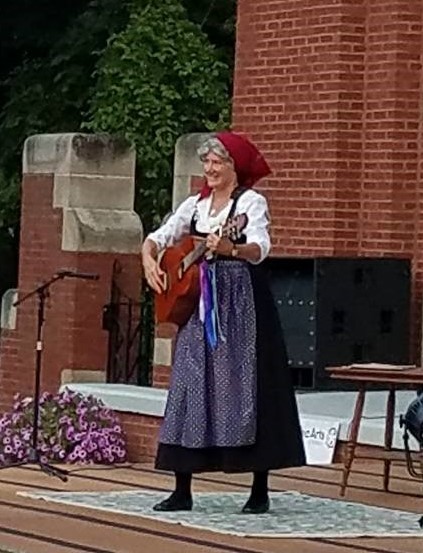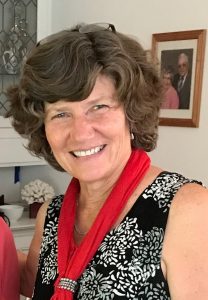
Event details
- June 10, 2024
- 7:30 pm - 9:00 pm
- Mauldin Cultural Center Outdoor Amphitheater, 101 East Butler Rd, Mauldin, SC 29662. Just off Laurens Rd (US 276.)
- 864-244-1499
Cost: Free
Mauldin Cultural Arts Center Amphitheater. Bring lawn seating.
In the case of inclement (extreme heat or rain) weather, show will be moved indoors. Doors will open at 7:15.
Events

Elsa Wolff, entertainer and educator, has been performing, teaching, singing and storytelling since 1997. Elsa, also known as “The Guitar Lady,” performs for elementary age children as well as senior citizens throughout the Denver area. In 2008, Elsa added Living History to her pursuits as she began portraying Amelia Earhart. Soon afterward, she added Minnie Pearl, Maria von Trapp and Annie Oakley to her repertoire. With excitement for this format of experiencing history, Elsa also became involved in Colorado Humanities’ Young Chautauqua Program and enjoys coaching students of all ages. Elsa earned a Bachelor’s degree in German from Willamette University, including several years of study abroad. Because of her love of music and the German language, Maria remains one of Elsa’s favorite characters to bring to life! Elsa is the mother of 4 children and lives in her native Colorado.
MARIA VON TRAPP – IMAGE AND TRUTH
One cannot talk about Maria von Trapp outside of the context of The Sound of Music. The 1959 Broadway musical was a hit with over 1,400 performances. However, the success of the musical paled in comparison to the popularity of the 1965 Oscar winning movie starring Julie Andrews. Maria von Trapp wrote her and her family’s story in her 1949 book, The Story of the Trapp Family Singers. The liberties the film producers took with her story are interesting to discover.
Who is Maria and was she really a problem? Maria was a woman of passionate faith and uncompromising determination. Woven throughout Maria’s life is a repeating theme of music, faith and courage. Maria’s life was defined and impacted by music; it had power to give joy and meaning and helped her give renewed life and purpose to the family she joined. It is important to realize that the beloved movie is loosely based on only a small portion of Maria’s real-life story that takes her from orphan to Baroness; from novice at Nonnberg Abbey to mother of 10 children; from refugee fleeing Nazi-controlled Austria to leading an internationally known singing group. More than once, she was called a “problem” but, more importantly, she shows us how she managed to overcome problems!
Born aboard a train to Vienna on January 26, 1905, Maria Kutschera was impatient and impulsive from the very start. Orphaned early on, Maria grew up enduring harsh conditions and an abusive uncle. She ran away from home as soon as she was old enough to put herself through college. At the age of 19, she decided to become a nun and went to Nonnberg Abbey in Salzburg. Two years later, in 1926, Maria was sent to be a tutor (not a governess) at the estate where Captain Georg von Trapp was raising his seven children, ages 4 to 14, alone. Their mother, Agathe von Trapp, had died of scarlet fever four years earlier.
A year later, Maria, now 22, married the Baron, who was 25 years her senior. Unfortunately, it is not the romantic story that we saw on the silver screen. She confessed: “I really and truly was not in love. I liked him but didn’t love him. However, I loved the children, so in a way I really married the children.”
Life radically changed for the family in 1931 when the Baron lost all his wealth in the worldwide financial collapse. It was at this time that Father Wasner, a Catholic priest with great musical knowledge, entered their lives . With his help, the family began performing together. The film makes no mention of this key figure in the lives of the Trapp Family but rather replaces him with a fictional figure, Max Detweiler.
Another of The Sound of Music’s significant deviations from reality concerns how the family escaped from Austria. Though we all love the song “Climb Every Mountain,” the family did not secretly hike over the Alps to Switzerland. Their escape from Nazi-controlled Austria began in 1938, eleven years after their marriage and the birth of two additional children. The Baron made it clear that he did not support the Nazi regime and refused a commission with the German Navy. When the popular family choir refused an invitation to sing at Hitler’s birthday party, Maria knew it was time to quickly leave. The family, known for their singing and hiking expeditions, simply boarded a train to Italy. From Italy they continued on to America. Maria was pregnant at the time and their tenth child was born in America. When they left Austria, they were accompanied by Father Wasner, who continued to act as their conductor for 20 years.
America did not offer immediate success as the family contended with serious setbacks. They faced issues with their visas, prejudice, financial strain and initially had difficulty connecting with American audiences. Maria continued to be the strong, determined leader, taking her large family through all hardships. She found not only success but established a lasting legacy.
The von Trapps established a homestead in Vermont, started a Singing Camp and continued performing. In 1943 Georg’s sons Rupert and Werner gladly joined America’s forces and served in the 10th Mountain Division. When the war was over, the Trapp family founded an organization called The Austrian Relief Inc. and were able to send donations of food and clothing to a needy Austria.
Maria wrote The Story of The Trapp Family Singers in 1949. In 1955, a German film company purchased Maria’s story and convinced her to sell her story, including all rights, royalties and control, for $9,000. Her impatience was a problem that cost the family untold millions.
Upon seeing the Broadway musical and later the film, The Sound of Music, the family was not entirely pleased. The children felt the film both fictionalized and simplified them and their story. They were especially distressed at the portrayal of the Baron as detached and disapproving, not the man they all knew as a loving, gentle and affectionate father. As Maria’s son Johannes said in a 1998 New York Times interview, “it’s not what my family was about… [We were] about good taste, culture, all these wonderful upper-class standards that people make fun of in movies like ‘Titanic.’ We’re about environmental sensitivity, artistic sensitivity. ‘Sound of Music’ simplifies everything. I think perhaps reality is at the same time less glamorous but more interesting than the myth.” Agathe, Maria’s eldest daughter, put it this way: “It’s a very nice story but it’s not our story. If they hadn’t used our name I probably would have enjoyed it.”
Maria and the children became American citizens 10 years after entering the country. At that time, they dropped “von” from their name. In all, The Trapp Family Singers performed for 20 years, singing more than 2,000 concerts throughout America and around the world.
Maria von Trapp passed away on March 28, 1987 and lies next to her husband in the family cemetery at the Trapp Family Lodge in Vermont. Only three of the ten children survive – Rosmarie, Eleonore and Johannes. The Lodge in Stowe, Vermont is still a popular resort and the family name is still associated with singing. May the music never end!
1905 Maria Augusta Kutschera born in Vienna on January 26th
1907 Maria’s mother, Augusta Kutschera, dies
1914 Maria’s father, Karl Kutschera, dies
1924 Maria becomes a candidate at Nonnberg Benedictine Convent
1926 Maria chosen to tutor young Maria von Trapp; goes to live at the villa with the Baron and his seven children
1927 Georg and Maria wed on November 26th
1929 Rosmarie, Maria and the Baron’s first child, is born
1931 Daughter Eleonore born. Family loses money in Bankruptcy
1936 The Von Trapps win amateur contest at Salzburg Music Festival.
1938 “Anschluss” Annexation of Austria by Nazi Germany; The Von Trapps flee Austria.
1939 Maria’s only son, Johannes von Trapp, is born Due to visa issue, family has to leave America, returning later that year
1942 The Trapp Family purchases farm in Stowe, Vermont
1944 Trapp Music Camp opens
1945 September – end of WWII. Trapp family raise money for “Austrian Relief Fund”
1947 Baron Georg von Trapp dies at 67 yrs. old
1949 Maria writes and publishes The Story of the Trapp Family Singers.
1956 Final Trapp Family Singers concert in the United States. “Die Trapp Familie” movie comes out in Germany
1959 “The Sound of Music” musical opens on Broadway
1965 “The Sound of Music” movie premieres in America
1968 Son, Johannes von Trapp, oversees opening of the Cross Country Ski Center, the first of its kind in the U.S.
1987 On March 28, Maria dies at 82 yrs old
–Quotes from The Story of the Trapp Family Singers
The Heart piece of our religion is to do the Will of God. It is the red thread that goes through the pattern of our life. God always provided a guiding star to lead us faithfully through all tempests of life. (p 103)
We learned a very important lesson—that music is the international language which speaks from heart to heart. (p 111)
Music acted as a magic key, to which the most tightly closed heart opened. (p270)
A family which sings together, plays together, and prays together, usually stays together. (p 272)
How stubborn the human heart is! Since it cannot live without hope, it hopes still against all hope. (p 295)
“They are a picture-book family!” How many times has that been said about us and written up in newspapers and magazines, and how hard did we try to correct this impression. (p 304)
–From Family on Wheels
Music can be a bond, a mission, drawing families, even nations, into common understanding. (p 31)
–From Maria: My Own Story
I loved the children, and so in a way I really married the children… By and by I learned to love (Georg) more than I have ever loved before or after.” (p 59f)
The Story of the Trapp Family Singers by Maria Augusta Trapp (1949)
The inspiration for Rodgers and Hammerstein’s beloved musical, The Sound of Music, here Maria Augusta Trapp tells the true story of the Trapp Family Singers.
A Family on Wheels: Further Adventures of the Trapp Family Singers by Maria Augusta Trapp (1959)
Picking up after the Trapp family’s arrival in America, this book covers the family’s adventures until their final performance in 1955.
Around the Year with the Trapp Family by Maria Augusta Trapp (1955)
A charming look into the holiday traditions and religious observations of the von Trapp family, including personal recipes, stories, and tips for incorporating these traditions into your own celebrations.
Maria: My Own Story by Maria Augusta Trapp (1972)
In her own words, Maria Augusta Trapp chronicles the story of her eventful life.
Maria von Trapp: Beyond the Sound of Music by Candice F. Ransom (2002)
Perfect for young readers, this book reaches beyond The Sound of Music and offers an insightful look into the life of Maria von Trapp.
